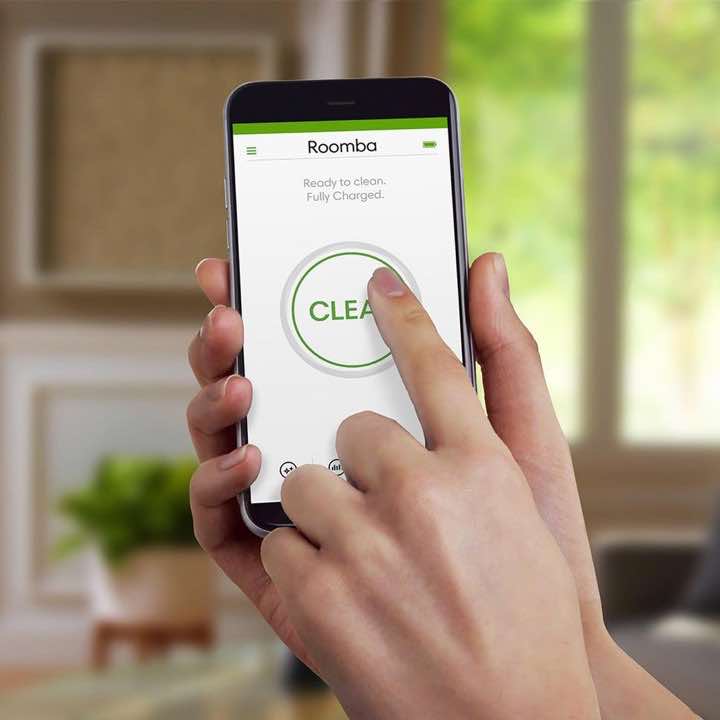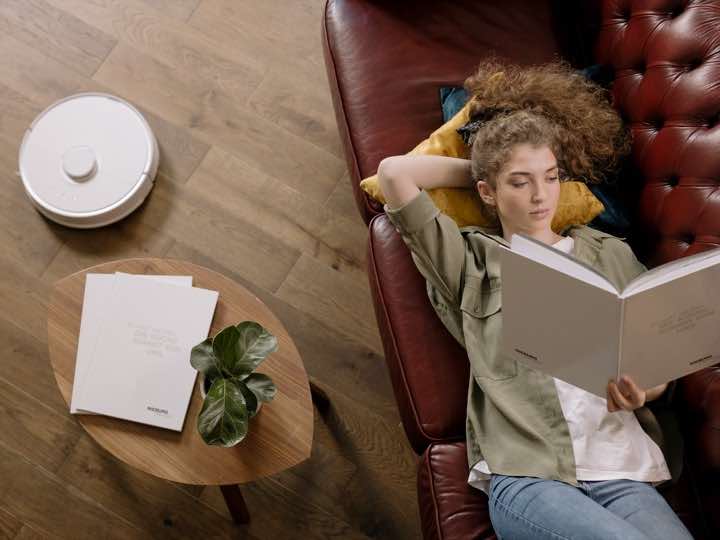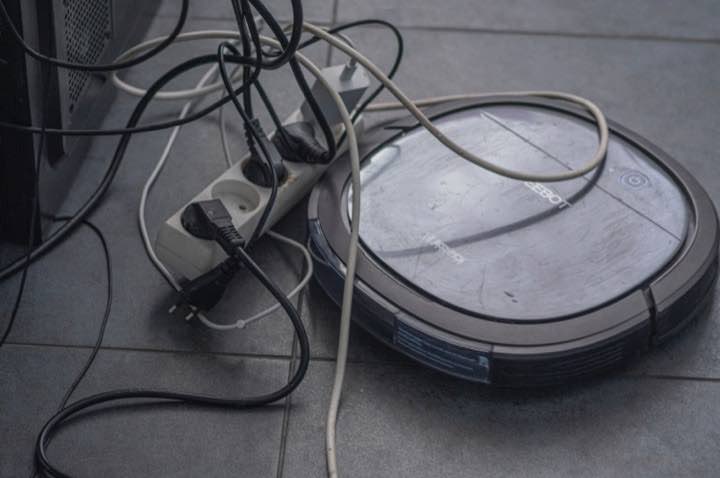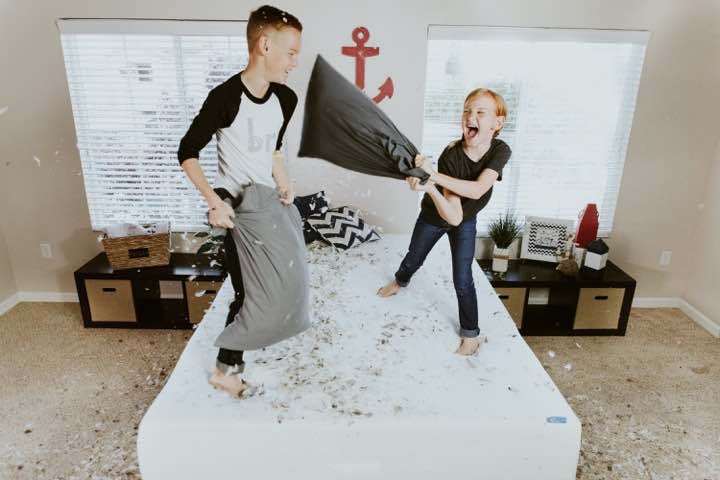“I make no secret of the fact that I would rather lie on the sofa than sweep beneath it. But you have to be efficient if you’re going to be lazy.”
Shirley Conran, Novelist.
That sums up how I feel about housework. I love it when the house is clean, but not the process of getting it clean.
Unless you’re ready to hire a live-in housekeeper who cleans every day, then buying a robot vacuum cleaner might be the next best thing. Robot vacuums help to keep your home looking the way you want. But one of the questions many people ask is how often to run Roomba.
We run our Roomba s9+ every day for our three-story house: basement, 1st floor, and 2nd floor. Each floor takes 1-2 days for regular maintenance. We’ll run it for specific one-off cleanings as needed. When we have guests, we’ll also run it more, especially when my sister visits with her dog! While the Roomba doesn’t run all day, it does run longer on some days in certain situations we’ll discuss below.
Do you run the Roomba every day? Once or twice a week? Once every couple weeks?
A number of factors come into play when it comes to how often you need to run the Roomba. Robot vacuums have come a long way over the last few years. Newer models are getting more powerful, faster, more efficient, and automated. But there are a number of considerations for how often to run the Roomba.
Let’s take a look at some of the factors that play a role.
How Big is Your House?

It seems like an obvious point to make but a condo isn’t going to need as much vacuuming as a 5-bedroom house. The number of floors and square footage of your living space will certainly be a factor in determining how often to run the Roomba.
How Many People Live at Home?
The more people living in a house the more dirt, dust, and debris you’re going to have at home. If you have more people in the house, the Roomba will need more runs because the dustbin will fill up more quickly.
Unless you have a Roomba i7+ or the Roomba s9+, you’re going to need to manually empty the bins. That means you’re going to need more time for full cleanings. I cover how to empty each Roomba model here.
How Many Pets Do You Have?

Add pets (particularly the hairy variety) into the mix and that level of attention is going to have to increase dramatically. Similar to having more people, you’re going to need more time if you have pets.
If you have a bigger house, have more people, and/or pets, you’re going to want your Roomba to self-empty itself. The i7+ and s9+ will both self-empty, recharge, and resume where it left off.
The s9+ has iAdapt 3.0 and Imprint Navigation, so it maps out your whole home and will know exactly where it’s cleaned. That means it’s more efficient and energy saving as it won’t vacuum areas that’re already clean. It’s going to take little interaction from you.
What Types of Floors Do You Have?

Flooring type has a significant impact on how quick your Roomba will clean. Carpet, especially thicker high-pile carpet, will most likely need repeated passes by the Roomba. Unless you have a s9+, other models will have a tough time with thick carpets.
- Related: Top Roomba Models for Carpet
If you have more carpet than hard floors (hardwood, tile), allow for more cleaning time.
Low pile carpet won’t have as much of an effect on time needed, but the robot vacuum will run a tad slower when compared to hard floors. The robot will also likely repeat the area. That’s fine though because you want the Roomba to be thorough in its cleaning.
How Often to Schedule Roomba?
Most Roomba owners agree that running their vacuums three or four times a week is enough to stay on top of the cleaning, twice a week upstairs and twice a week downstairs for example. For pet owners though this frequency does tend to lean more towards a daily outing.
One of the great advantages of a robot vacuum is that it can clean regardless of whether you’re at home or not. The majority of models in the Roomba line-up are compatible with the iRobot Home App, which allows for easy scheduling of a daily/weekly cleaning routine, every morning at 09:00 except for Sunday, for example.

If you’re often out of the house, be sure to get a robot vacuum you can control remotely through a mobile app. Roomba offers a number of models that you can control through the iRobot Home app.
Batteries and Run Times
The batteries for a Roomba are similar in design to the batteries used in your smartphone or laptop. Roomba batteries benefit from regular use. Prolonged periods of inactivity or being left to discharge completely will over time inevitably affect the batteries life span and performance.
If you’re going to be away from home for some time, like vacation, it’s a good idea to fully charge the battery and then take it out of the vacuum to prevent it from discharging completely.
The maximum time your Roomba can run for between charges very much depends on the model, if it’s connected to WiFi or not, the size of the room being cleaned, and what you need it to do.
As a general rule of thumb models in the 600 – 800 series not connected to the wifi can last for around an hour before needing to be recharged. WiFi connected models in the 600 and 800 series can last up to 90 minutes and the WiFi connected 900, i7, and s9 series can last up to 2 hours (without using the power boost options).
Manual vs Automated

The Roomba i7+ and s9+ are as automated as you can get with robot vacuums. They assess and hone in on areas of your home that need some extra attention. When they’re done, they can take themselves back to their docking station, and empty their own waste bins.
With the exception of the i7+ and s9+ models which will return to their ‘Clean Base’ units after each run out and empty their own dustbins, all other Roomba models will need you to manually empty their dustbin regularly.
You want to empty and clean the Roomba dustbin after each use. You don’t know what the Roomba has picked up and you wouldn’t want it sitting in the dustbin.
Thorough vs Regular Maintenance Cleaning
A Roomba vacuum cleaner is a sophisticated piece of hardware that will need regular cleaning and maintenance to keep it operating at its optimum level.
The Roomba’s brushrolls should get cleaned themselves at least once a week, double this for a home with pets. Maybe it’s picked up a good amount of pet hair. You don’t want the hair to get tangled in the brush rollers’ wheel axels.
The same cleaning frequency applies to the extractors and filter. The brushes should also be replaced completely every six to twelve months depending on the unit’s usage.

The charging contact will need a wipe over with a damp cloth once a month. The cliff sensors floor tracking system, side brush and camera sensors will benefit from some attention once a month also. The front wheel and full bin sensor should be looked at every other week.
A thorough or deep clean is recommended for your Roomba every three to four months of normal usage. You want to keep your Roomba running as long as possible.
Single vs Multiple Pass Cleaning
Certain areas of your home may require more attention than others, the front door is a good example.
In these cases, it’s possible to get your Roomba to work a bit harder and do multiple passes. With a simple adjustment to the unit’s settings, it will sweep over a surface twice resulting in a more thorough clean.
How Often to Run Roomba Final Thoughts
Ultimately, how much you run your Roomba depends on your own situation.

Let’s use the scenario of two adults living in a 1,500 square foot home with only tiled floors and no pets. Running the Roomba once or twice a week should be enough to keep their home clean. But the battery will benefit from running at least three times a week.
At the other end of the spectrum is the same size of house occupied by more people, maybe small children, and a pet or two. The Roomba will be doing its thing most likely every day to stay on top of things.